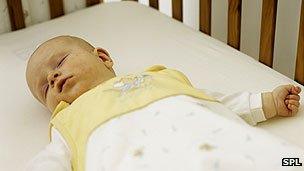Cot deaths advice 'did not reach deprived areas'
- Published

Official advice is to put babies on their backs to sleep in a cot or crib, not on a sofa
A campaign to change babies' sleeping positions and reduce cot death rates in the 1990s failed to get the message across to deprived communities, a study has suggested.
It took up to 15 years for the death rate to reach "a low and stable rate" in those areas, researchers found.
The University of Cambridge study looked at sudden infant deaths in Scotland from 1985 to 2008.
Future campaigns should target people in areas of high deprivation, it said.
The 'Back To Sleep' campaign, which was launched in November 1991, aimed to get parents to put their babies to sleep on their backs.
This was known to lower the risk of sudden infant death syndrome (SIDS) or cot death, which affected about 1 in 500 live-born babies in the 1980s.
At present, fewer than one in 2,000 babies in the UK dies from SIDS.
The Cambridge study found a sharp decline in the rate of sudden infant death syndrome among women living in areas of low socioeconomic deprivation in Scotland between 1990 and 1993.
Yet among women living in areas of high socioeconomic deprivation, the study found a much slower decline in the rate of sudden infant death syndrome between 1992 and 2004.
'Abrupt decline'
Prof Gordon Smith, author of the study from the department of obstetrics and gynaecology at the University of Cambridge, said the campaign had a global reach but needed to be more targeted.
"Ultimately, Back To Sleep was a huge success and helped to stimulate an abrupt decline in the rate of sudden infant death syndrome all over the world.
"Clearly, however, it was much slower where deprivation was high."
The study found that in the UK in areas of low deprivation, the maximum beneficial effect was achieved in just two to three years.
"In contrast, it took 10 to 15 years for the campaign to reach the same low levels in deprived communities," Prof Smith said.
He said that any future campaigns seeking to reduce risk factors for stillbirth and infant death should bear this in mind.
"One lesson we can learn from this is that we may need to make special efforts in future public health campaigns to reach the most deprived sections of society, the people who often need to hear the message most."
'Good access'
Ian Currie, from the Royal College of Obstetricians and Gynaecologists, said it was worrying that rates reduced more slowly in deprived areas.
"More certainly needs to be done to raise awareness amongst all women as to the possible causes of infant mortality and stillbirth. Women living in deprived communities especially need extra support and good access to information.
"Other factors associated with infant death and stillbirth include smoking in pregnancy, alcohol consumption and obesity. It is vital that pregnant women receive appropriate levels of support before birth and post birth."
Prof George Haycock, scientific adviser for the Foundation for the Study of Infant Deaths, said the study was well-constructed.
He said: "We agree with Prof Smith and his colleagues that the 1991 campaign did reduce the SIDS rate - 70% in the UK - but that there is no doubt that other pieces of advice and factors may well have contributed to the decline."
The study also found that wide publication of the results of a UK study in 1990, showing that babies were at lower risk of SIDS when lying on their backs, resulted in a dramatic fall in SIDS rates one year before the campaign began.
- Published17 August 2011
- Published11 January 2012